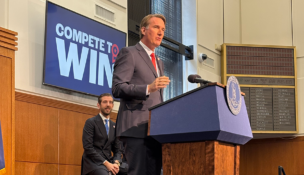Rebuilding VEDP
New leader responds to concerns and rolls out a strategic plan
Rebuilding VEDP
New leader responds to concerns and rolls out a strategic plan
For Stephen Moret, 2017 was a rebuilding year. The president and CEO of the Virginia Economic Development Partnership (VEDP) faced a daunting task: overhauling the state’s primary business recruitment agency while beginning to restore the commonwealth’s reputation as one of the best states for business.
Fourteen months into the job, Moret and others say VEDP is back on solid ground. A five-year strategic plan positions the agency to move forward with initiatives such as a more robust marketing effort and a new emphasis on customized workforce recruitment and training.
“They have made great strides to improving the situation and to improving the things that needed to be addressed,” says Hal Greer, director of Virginia’s investigative watchdog, the Joint Legislative Audit and Review Commission (JLARC). “They are on the way to being an effective agency.”
That’s high praise considering the criticism VEDP faced from JLARC, Virginia’s investigative watchdog, shortly before Moret took over. JLARC released a 132-page report in November 2016 lambasting VEDP as an organization with slipshod management and an unstructured approach to incentive grants that left the state vulnerable to fraud. “In my 22 years, I’ve never seen an agency with this level of dysfunction,” Greer said at the time of JLARC’s report.
A catalyst for JLARC’s intervention was a $1.4 million incentive grant Virginia gave to Lindenburg Industry, a Chinese company that reneged on a plan to build a plant in Appomattox that was expected to create 350 jobs.
Despite ongoing legal action and a criminal investigation by State Police — which reported that VEDP relied upon a bogus company website during its vetting process — Virginia has yet to collect any money.
Not surprisingly, Moret says the central focus of his first year has been responding to 27 recommendations in the JLARC report. “Nothing was more important than addressing the major recommendations. Of the 27, we have substantially implemented 25 of them and still have a couple of things to do,” says Moret, who plans to wrap things up with a final update by June.
New incentives division
Chief among the recommendations was the creation of a separate incentives division. The Lindenburg incident, says Moret, represented “a systemic failure” in how VEDP conducted due diligence and monitored incentives.
Under the system in place before 2016, he explains, individual project managers vetted a company’s credibility and fiscal soundness before the state awarded incentive money. Frequently the grants would be given upfront, before a company had carried out plans to build a facility or create jobs. There was no comprehensive incentive reporting or monitoring after a deal was done.
Since the Lindenburg deal collapsed, two other companies, Vastly (formerly Tranlin) in Chesterfield County and a foundry in Radford have not paid back money on troubled projects. In both cases, VEDP has pursued legal action. For example, it has taken a lien on a property involved in the Vastly project.
The JLARC report criticized VEDP for not enforcing performance contract provisions, increasing the state’s exposure to financial loss. It said VEDP did not enforce clawback provisions on 23 projects that received incentive grants between 2006 and 2015 but failed to meet performance requirements on capital investment or job creation. Initially, JLARC said this lax enforcement meant that $8.7 million had slipped through VEDP’s hands.
That figure, Moret says, was later whittled down to a much smaller amount — VEDP board member Dan Clemente puts the number at $180,000. Subsequent investigation showed that some of the 23 companies had met their requirements or that VEDP had closed out the accounts, indicating to the companies that requirements had been fully met, even if they had not. “I think the board felt it would be awkward and, candidly, we would probably lose legally, if we went back and sought collection after the previous staff had closed the account out,” Moret says.
In the new division that opened in September, four full-time staff members now oversee incentives administration. The vetting process has been refined, and a risk rating is assigned to every firm and incentive. Typically, Moret says, only companies considered low risk for failure would be given grants upfront. Companies considered a higher risk would get money only after meeting certain performance goals.
If a company receives money and doesn’t perform as expected, VEDP can look for help with collections from the attorney general’s office. This power was added as part of the reform legislation that came out of the General Assembly as a result of JLARC’s study.
Heading the new incentives division is Scott Parsons, who previously was executive director of the Virginia Small Business Financing Authority. He is one of several new hires on Moret’s staff.
Del. S. Chris Jones, R-Suffolk, chairman of the House Appropriations committee and a JLARC member, is pleased with VEDP’s progress since Moret took the helm. “I think things are going very well.”
Jones thinks reducing VEDP’s board from 24 to 18 members — another General Assembly reform — is a big improvement. Moret and Jones both support the addition of state cabinet secretaries, including the secretary of finance, as ex-officio members of the board. The secretary of commerce and trade serves as the board’s vice chair. Since virtually all of VEDP’s funding comes from the state, “it’s critical that we develop and maintain very close relationships with at least the General Assembly leadership,” says Moret.
More funding
Those relationships should come in handy in a year when Moret is seeking millions of new dollars for the creation of a custom recruitment and workforce training incentive program that would be run in partnership with Virginia’s community college system. VEDP sought an additional $4.6 million in fiscal 2019 of the biennial budget for the program and $8.2 million in the second year, on top of VEDP’s annual operating budget of about $27 million.
Former Gov. Terry McAuliffe’s budget proposal included a little more than half of the $12.8 million sought, with $2.5 million in the first year and $5 million in the second. “That is enough to create a solid program,” says Moret, “but it would not enable us to serve as many companies as we would like to be able to serve.”
At press time, the House had proposed an additional $5 million over the biennium, over and above McAuliffe’s recommendation, with the money earmarked for marketing and business-ready development sites.
For marketing alone, Moret had proposed an additional $9.5 million in each of the two years to rev up third-party marketing, including social media, print and online marketing materials, direct mail and sponsored events.
Compared to other states, Virginia has basically zero in its budget for economic development marketing. “If you look at states like Georgia, Florida, Ohio and Louisiana, they would almost always be in the $5 million to $10 million range,” notes Moret. “Other states are investing and telling their story, and we’re not.”
Already raising Virginia’s profile is the fact that Northern Virginia made the cut for a final pool of 20 sites that Amazon is considering for its second corporate headquarters. Moret refers to the project as the “economic prize of the century,” because it represents $5 billion in investment and 50,000 high-paying jobs over 15 to 17 years. Amazon is expected to make its decision later this year.
Besides creating a new workforce training program that Moret says would initially need a staff of at least 12 people, he has other goals in mind this year. He would like to see VEDP invest in more business-ready sites, particularly in rural areas, and expand VEDP’s international trade programs.
Joshua Lewis, the CEO and director of Virginia’s Industrial Advancement Alliance in Southwest Virginia, welcomes Moret’s embrace of prosperity for rural areas and his penchant for analytics in goal setting. To meet the state’s job growth goals, “We need 700 new jobs in our region in five years. It’s the magic number to ensure that we’re not going to continue to contract in population,” says Lewis. To get there, the plan supports many of the region’s needs, including more broadband, a trained workforce and business development sites.
At this stage in VEDP’s evolution, Lewis says the morale in rural areas among economic developers has improved, because of Moret’s approach. “He’s not shying away from what needs to be done … It all depends on the resources VEDP is given to accomplish the goals.”
Vincent Mastracco, chair of VEDP’s board, is optimistic about the agency’s future. “I feel much better about VEDP than I did earlier,” says Mastracco, who was appointed to the board in 2016. “The board today is far more engaged in VEDP activities and undertakings.”
If the General Assembly can’t find a way to provide more money, another option, which Mastracco says the board has discussed, would be to create a dedicated revenue source for VEDP. Other states have funded their economic development agencies by designating a certain portion of a tax or fee for economic development.
In the meantime, “I would give Stephen an A-plus so far on leadership, perseverance and work ethic. He motivates his staff. He leads by example, and he leads intelligently by challenging the board to advise him on their attitudes on policy issues… I’m convinced that VEDP is on the right path.“
S
















